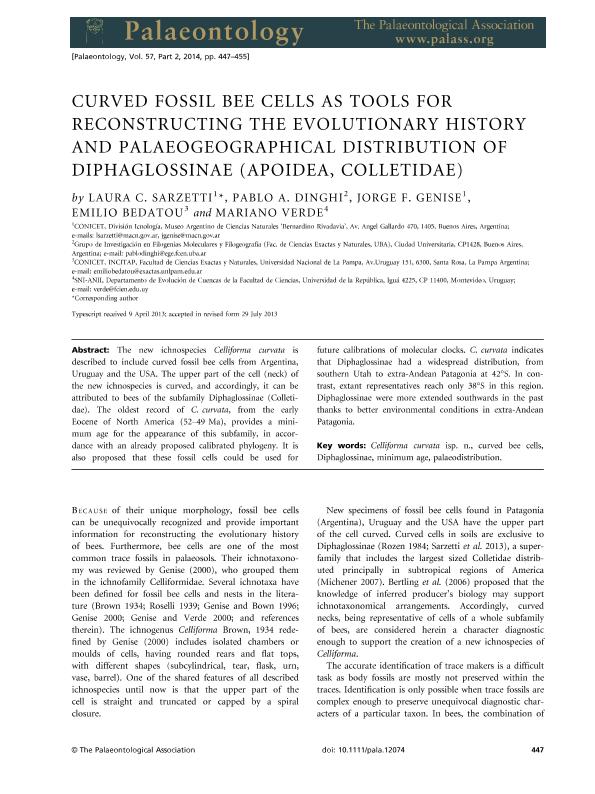Artículo
Curved fossil bee cells as tools for reconstructing the evolutionary history and geographic palaeodistribution of Diphaglossinae (Apoidea, Colletidae)
Sarzetti, Laura Cristina ; Dinghi, Pablo Adrián
; Dinghi, Pablo Adrián ; Genise, Jorge Fernando
; Genise, Jorge Fernando ; Bedatou, Emilio
; Bedatou, Emilio ; Verde, Mariano
; Verde, Mariano
 ; Dinghi, Pablo Adrián
; Dinghi, Pablo Adrián ; Genise, Jorge Fernando
; Genise, Jorge Fernando ; Bedatou, Emilio
; Bedatou, Emilio ; Verde, Mariano
; Verde, Mariano
Fecha de publicación:
01/2014
Editorial:
Wiley Blackwell Publishing, Inc
Revista:
Palaeontology
ISSN:
0031-0239
Idioma:
Inglés
Tipo de recurso:
Artículo publicado
Clasificación temática:
Resumen
The new ichnospecies Celliforma curvata is described to include curved fossil bee cells from Argentina, Uruguay and the USA. The upper part of the cell (neck) of the new ichnospecies is curved, and accordingly, it can be attributed to bees of the subfamily Diphaglossinae (Colletidae). The oldest record of C. curvata, from the early Eocene of North America (52-49 Ma), provides a minimum age for the appearance of this subfamily, in accordance with an already proposed calibrated phylogeny. It is also proposed that these fossil cells could be used for future calibrations of molecular clocks. C. curvata indicates that Diphaglossinae had a widespread distribution, from southern Utah to extra-Andean Patagonia at 42°S. In contrast, extant representatives reach only 38°S in this region. Diphaglossinae were more extended southwards in the past thanks to better environmental conditions in extra-Andean Patagonia.
Archivos asociados
Licencia
Identificadores
Colecciones
Articulos(MACNBR)
Articulos de MUSEO ARG.DE CS.NAT "BERNARDINO RIVADAVIA"
Articulos de MUSEO ARG.DE CS.NAT "BERNARDINO RIVADAVIA"
Citación
Sarzetti, Laura Cristina; Dinghi, Pablo Adrián; Genise, Jorge Fernando; Bedatou, Emilio; Verde, Mariano; Curved fossil bee cells as tools for reconstructing the evolutionary history and geographic palaeodistribution of Diphaglossinae (Apoidea, Colletidae); Wiley Blackwell Publishing, Inc; Palaeontology; 57; 2; 1-2014; 447-455
Compartir
Altmétricas



